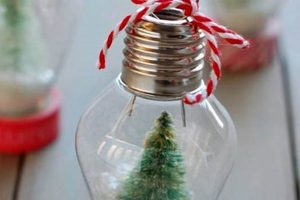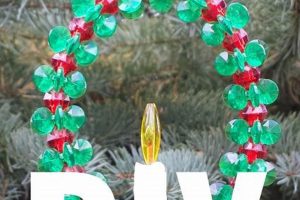Large-scale decorative spheres, typically employed during seasonal festivities, are crafted by individuals for display in residential or commercial environments. These oversized adornments can be fashioned from a variety of materials, ranging from repurposed plastics to durable fabrics, and are intended to create a visually striking focal point.
The utilization of handcrafted, sizable decorations presents opportunities for cost-effective beautification of spaces and fosters a sense of creative expression. Historically, ornamentation during celebrations has served to enhance communal spirit and mark significant occasions. The creation of these decorations promotes resourcefulness and can be a sustainable alternative to commercially produced items.
The subsequent sections will detail specific materials suitable for crafting these decorations, outline step-by-step construction methods, and provide guidance on incorporating lighting elements for enhanced visual appeal.
DIY Giant Ornaments
The creation of oversized decorative spheres requires careful planning and execution. The following recommendations are intended to optimize the construction process and ensure a durable, visually appealing final product.
Tip 1: Material Selection: Opt for weather-resistant materials such as treated plywood, heavy-duty plastic sheeting, or marine-grade rope. These choices will enhance the ornament’s longevity when exposed to outdoor elements. For example, a plywood base coated with exterior paint provides a solid, weatherproof foundation.
Tip 2: Structural Integrity: Prioritize a robust internal structure. Consider utilizing a geodesic dome design or a reinforced frame constructed from metal or wood. A well-engineered frame will prevent collapse or deformation under its own weight and external forces.
Tip 3: Seam Reinforcement: When using fabric or plastic, employ reinforced stitching or industrial-grade adhesive to secure seams. Double-stitched seams with UV-resistant thread will minimize the risk of separation due to environmental degradation.
Tip 4: Weight Distribution: Evenly distribute the weight of any internal components, such as lighting or decorative elements. Uneven weight distribution can compromise the structural integrity and lead to instability during display.
Tip 5: Lighting Integration: Use low-voltage LED lighting systems to minimize the risk of electrical hazards and heat generation. Waterproof LED strips or individually encased bulbs offer safe and energy-efficient illumination.
Tip 6: Secure Mounting: Implement a secure mounting system using heavy-gauge wire, chains, or bolts appropriate for the ornament’s size and weight. Ensure the mounting point can bear the full load with a significant safety margin.
Tip 7: Weather Protection: Apply a protective coating, such as a UV-resistant sealant or a waterproof paint, to shield the ornament from sun, rain, and snow. Regular maintenance will extend the ornament’s lifespan and prevent fading or deterioration.
Following these guidelines will contribute to the creation of substantial decorative pieces that are both visually striking and structurally sound. Investing in quality materials and meticulous construction techniques will result in durable, long-lasting ornamentation.
The subsequent section will address the aesthetic considerations involved in the design and decoration of these large-scale items, focusing on color palettes, textural elements, and thematic approaches.
1. Scale
The dimension of an oversized decorative sphere is a primary determinant in its visual impact, material requirements, structural design, and logistical considerations. Selection of an appropriate dimension necessitates a comprehensive evaluation of the intended display location, available resources, and desired aesthetic effect.
- Visual Dominance
The size of the ornament directly influences its prominence within a given environment. A larger sphere commands greater attention, potentially serving as a central focal point. However, an inappropriately large object may overwhelm the surrounding space, diminishing the overall aesthetic appeal. Careful consideration must be given to the existing architecture and landscape to ensure harmonious integration.
- Material Quantity and Cost
The surface area increases exponentially with linear dimensions. Consequently, a modest increase in diameter can result in a substantial escalation in the quantity of materials required for construction. This, in turn, directly impacts the overall project cost. Material selection must therefore balance aesthetic desires with budgetary constraints, considering factors such as price per unit, availability, and workability.
- Structural Complexity
As the size increases, the structural demands placed upon the ornament necessitate more sophisticated engineering and construction techniques. Larger spheres require robust internal frameworks capable of withstanding wind loads, snow accumulation, and their own weight. The design must account for these factors, potentially incorporating geodesic dome structures, reinforced frames, or tension cables to ensure stability and prevent collapse.
- Logistical Feasibility
The physical dimensions of the finished product directly affect transportation, installation, and storage requirements. Larger ornaments may necessitate specialized equipment for lifting and placement, as well as significant storage space during off-season periods. A thorough assessment of logistical challenges is crucial to ensure the project’s viability, including access to the display site, availability of appropriate machinery, and adequate storage facilities.
Therefore, determining the optimal scale of the decorative sphere represents a critical initial step in the creation process. Balancing aesthetic considerations with practical constraints related to material cost, structural integrity, and logistical feasibility is paramount to achieving a successful and visually compelling result.
2. Materials
Material selection is a pivotal aspect in the creation of substantial decorative spheres, influencing their structural integrity, aesthetic appeal, and long-term durability. The chosen materials directly impact the ornament’s ability to withstand environmental stressors and maintain visual integrity over extended periods.
- Structural Substrates
The foundational framework necessitates materials capable of supporting the ornament’s weight and resisting deformation. Options include welded steel frames offering robust strength and dimensional stability, plywood providing a lightweight and cost-effective alternative, and durable plastic sheeting for weather resistance. The substrate’s strength directly correlates with the ornament’s ability to withstand wind and snow loads, ensuring structural safety.
- Surface Finishes
The outermost layer dictates the visual appearance and protection against weathering. Exterior-grade paints provide color and a barrier against moisture and UV radiation. Fabrics, such as canvas or vinyl, offer textural variation and can be treated for water resistance. Reflective materials, including metallic films or glass beads, enhance visibility and add decorative elements. The selected finish must be compatible with the substrate and offer long-term protection against environmental degradation.
- Fasteners and Adhesives
Securing components relies on robust fasteners and adhesives suited to the selected materials. Welds offer permanent connections for metal frames. Screws and bolts provide mechanical fastening for wood and plastic. Industrial-grade adhesives bond surfaces and create watertight seals. The selected fastening method must withstand stress and temperature fluctuations, preventing component separation and ensuring structural integrity.
- Internal Reinforcements
Internal supports augment the structural stability and prevent deformation. Metal struts or wooden cross-braces reinforce the framework, distributing weight and resisting bending forces. Tension cables add tensile strength, preventing sagging and maintaining shape. Internal reinforcements are particularly crucial for larger ornaments, mitigating stress and ensuring long-term structural integrity.
The interplay between these material components determines the overall success of the decorative sphere. Careful consideration of material properties, compatibility, and environmental resistance is essential for crafting durable, visually appealing, and structurally sound ornamentation.
3. Structure
The structural design of large-scale decorative spheres dictates their stability, longevity, and resistance to environmental factors. A well-engineered structure is paramount to ensuring the ornament maintains its form and withstands external forces.
- Internal Framework
The internal framework serves as the primary load-bearing component. Geodesic dome structures, constructed from interconnected struts, distribute stress evenly, providing exceptional strength for their weight. Alternatively, welded steel frames offer robustness but require specialized fabrication skills. The framework must be designed to support the weight of the cladding and any internal components, such as lighting systems.
- Cladding Attachment
The method of attaching the cladding to the framework is critical to preventing separation and maintaining a smooth, uniform surface. Rivets, screws, and industrial-grade adhesives are commonly employed, depending on the materials used. Attachment points must be strategically located to distribute stress and prevent localized failures. For fabric cladding, reinforced stitching or grommets can provide secure attachment and prevent tearing.
- Base and Support System
The base and support system must provide a stable foundation and prevent tipping or movement. A weighted base or anchoring system is essential, particularly in windy conditions. For suspended ornaments, robust hanging hardware and secure attachment points are necessary. The support system must be designed to withstand the full weight of the ornament and any additional loads imposed by wind or snow.
- Material Compatibility
The materials used for the structure and cladding must be compatible to prevent corrosion, degradation, or differential expansion. For example, dissimilar metals can cause galvanic corrosion in the presence of moisture. The selected materials should also have similar thermal expansion coefficients to minimize stress and prevent warping or cracking.
Effective structural design is not merely an aesthetic consideration but a fundamental requirement for safe and durable large-scale decorations. Careful attention to the internal framework, cladding attachment, support system, and material compatibility will ensure the ornament withstands environmental challenges and maintains its visual appeal for years to come.
4. Durability
The long-term viability of large-scale decorative spheres is inextricably linked to material resilience and robust construction techniques. Degradation resulting from exposure to environmental stressors, such as ultraviolet radiation, precipitation, and temperature fluctuations, directly impacts the ornament’s structural integrity and aesthetic appeal. The selection of weather-resistant materials and the implementation of protective coatings are, therefore, critical determinants of the ornament’s lifespan. For instance, untreated wooden structures rapidly deteriorate when exposed to moisture, whereas those coated with marine-grade varnish exhibit significantly prolonged resistance to decay. Similarly, fabrics susceptible to UV degradation quickly fade and weaken, necessitating the use of UV-resistant textiles or protective treatments to maintain their integrity.
Furthermore, the method of assembly and the quality of fasteners employed directly affect the ornament’s ability to withstand physical stress. Weak or corroded fasteners compromise the structural integrity, increasing the risk of component separation or complete collapse. Welding, bolting, or the application of industrial-grade adhesives provide stronger, more durable connections, particularly in environments subject to high winds or heavy snow loads. A real-world example can be found in public installations, where inadequate construction techniques often lead to premature failure, resulting in costly repairs or replacements. In contrast, properly engineered structures utilizing high-quality materials and robust assembly methods demonstrate superior longevity, minimizing maintenance requirements and maximizing the return on investment.
In summary, prioritizing durability in the creation of oversized decorative spheres necessitates a comprehensive approach encompassing material selection, construction techniques, and protective measures. While aesthetic considerations are undoubtedly important, neglecting the structural integrity and environmental resilience can lead to premature failure, negating the initial cost savings and undermining the overall value proposition. A focus on durability ensures long-term aesthetic appeal, minimizes maintenance, and contributes to the overall sustainability of the project.
5. Aesthetics
The visual appeal of large-scale decorative spheres significantly contributes to their overall impact and acceptance. Integrating aesthetic principles into the design and construction process is essential to creating visually compelling and harmonious ornamentation.
- Color Palette Selection
The choice of colors profoundly affects the ornament’s visual impact and its interaction with the surrounding environment. Complementary color schemes can create a harmonious and balanced appearance, while contrasting colors generate visual interest and dynamism. Consideration must be given to the existing color palette of the display location to ensure a cohesive and aesthetically pleasing integration. For example, a muted color palette may be appropriate for a natural setting, while bold, vibrant colors may be suitable for a more urban environment.
- Surface Texture and Pattern
The texture and pattern of the ornament’s surface contribute to its tactile and visual interest. Smooth, reflective surfaces create a sense of elegance and sophistication, while textured surfaces provide visual depth and complexity. Patterns, whether geometric or organic, can add visual interest and reinforce a specific theme or style. The selection of surface texture and pattern should complement the overall design and enhance the ornament’s visual appeal. For instance, a textured surface may be used to simulate the appearance of natural materials, while a geometric pattern can create a modern and abstract aesthetic.
- Lighting Integration and Effects
The integration of lighting elements can significantly enhance the ornament’s visual impact, particularly during nighttime display. Strategically placed lighting can accentuate specific features, create dramatic shadows, and transform the ornament’s appearance. The choice of lighting color, intensity, and pattern can profoundly affect the overall aesthetic effect. For example, warm-toned lighting can create a cozy and inviting atmosphere, while cool-toned lighting can generate a sense of drama and sophistication. Color-changing LEDs allow for dynamic and customizable lighting effects, enhancing the ornament’s visual appeal and versatility.
- Thematic Coherence and Style
The ornament’s design should reflect a clear thematic concept and stylistic approach. Whether it is a traditional holiday theme, a modern abstract design, or a whimsical artistic expression, the ornament should convey a cohesive and intentional message. The choice of materials, colors, textures, and patterns should all contribute to the overall thematic coherence. For example, a nautical-themed ornament might incorporate rope, netting, and blue and white colors, while a futuristic design might feature sleek metallic surfaces and geometric patterns.
In conclusion, aesthetic considerations are crucial in the creation of oversized decorative spheres. By carefully selecting colors, textures, patterns, and lighting, and by adhering to a cohesive thematic concept, individuals can create visually stunning and impactful ornamentation that enhances the aesthetic appeal of its surroundings.
6. Safety
The construction and deployment of large-scale decorative spheres introduce significant safety considerations that must be addressed to prevent accidents and injuries. The sheer size and weight of these creations, coupled with potential environmental factors, necessitate a rigorous approach to risk assessment and mitigation. Neglecting safety protocols can lead to structural failures, resulting in falling debris or complete collapse, posing a direct threat to individuals and property. For instance, an improperly secured ornament dislodged by high winds can cause substantial damage to structures or inflict serious harm upon bystanders. Consequently, adherence to established safety standards is paramount in every phase, from design and material selection to installation and maintenance.
Practical safety measures include, but are not limited to, comprehensive structural analysis to ensure the ornament can withstand anticipated loads, employing certified rigging techniques for installation, and conducting routine inspections to identify potential weaknesses or deterioration. Material selection plays a critical role, favoring fire-retardant substances to minimize the risk of fire hazards, especially when incorporating lighting elements. Furthermore, adequate grounding and weatherproofing of electrical components are essential to prevent electrical shocks and short circuits. Public access must also be considered, implementing barriers or warning signs to prevent unauthorized climbing or tampering, which could compromise structural integrity and increase the risk of accidents. Examples of such safety implementation can be seen by inspecting many outdoor decors in various big cities where these implementations is observed and has been proved.
In conclusion, the creation and display of these oversized decorations are inherently associated with potential hazards that demand meticulous planning and execution. The integration of safety principles is not merely a regulatory obligation but a moral imperative, ensuring the well-being of individuals and the protection of property. Emphasizing structural integrity, employing appropriate materials, and implementing rigorous safety protocols are essential components of responsible large-scale ornamentation, minimizing the risk of accidents and fostering a safe environment for all.
Frequently Asked Questions
The following section addresses common inquiries regarding the design, construction, and deployment of large-scale decorative spheres. These responses are intended to provide clarity and guidance for individuals undertaking such projects.
Question 1: What is the minimum safe distance required between a large-scale decorative sphere and overhead power lines?
A minimum clearance of ten feet is generally recommended to mitigate the risk of electrical arcing. Consult local utility regulations for specific requirements in a given jurisdiction.
Question 2: Which type of adhesive is most suitable for bonding weather-resistant fabric to a metallic frame?
A solvent-based contact adhesive formulated for outdoor use is generally recommended. Ensure the adhesive is compatible with both the fabric and metal substrates.
Question 3: How can the structural integrity of a geodesic dome used as a base for a large ornament be assessed?
A structural engineer should be consulted to perform a load analysis, considering wind loads, snow loads, and the weight of the ornament itself. This assessment should verify the dome’s capacity to withstand anticipated forces.
Question 4: What type of lighting system minimizes the risk of overheating within a closed decorative sphere?
Low-voltage LED lighting systems generate minimal heat and are recommended for enclosed environments. Ensure the system is properly ventilated to prevent heat accumulation.
Question 5: How frequently should large-scale decorative spheres be inspected for structural integrity?
A visual inspection should be conducted at least quarterly, with a more thorough inspection performed annually by a qualified professional. Inspections should focus on identifying signs of corrosion, material degradation, and structural weaknesses.
Question 6: What is the recommended method for securing a large-scale decorative sphere to a concrete surface in a high-wind environment?
The use of anchor bolts embedded in the concrete, coupled with heavy-gauge chains or cables, is recommended. The anchoring system should be designed to withstand the maximum anticipated wind load.
Adherence to these guidelines, along with comprehensive planning and execution, contributes to the safe and successful creation of large-scale decorative spheres.
The following section will explore case studies of successful large-scale decorative sphere installations, highlighting best practices and lessons learned.
DIY Giant Ornaments
The preceding exploration of “diy giant ornaments” has underscored critical aspects ranging from structural integrity and material selection to aesthetic considerations and paramount safety protocols. Success in this domain necessitates a comprehensive understanding of engineering principles, environmental factors, and rigorous construction techniques. Deviations from established best practices can lead to structural failures and potentially hazardous situations.
The responsible creation and deployment of substantial decorative spheres demand meticulous planning, unwavering attention to detail, and a commitment to prioritizing safety above all else. Further research and adherence to industry standards are strongly encouraged to ensure the long-term stability, aesthetic appeal, and, most importantly, the safety of any such undertaking. The pursuit of visually striking ornamentation should never compromise the well-being of individuals or the integrity of the surrounding environment.







